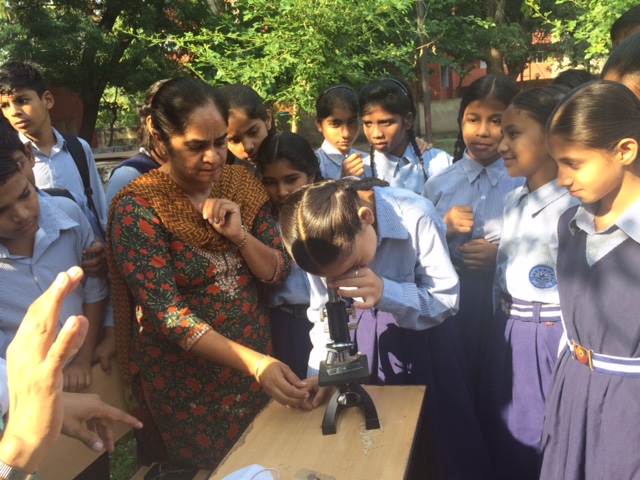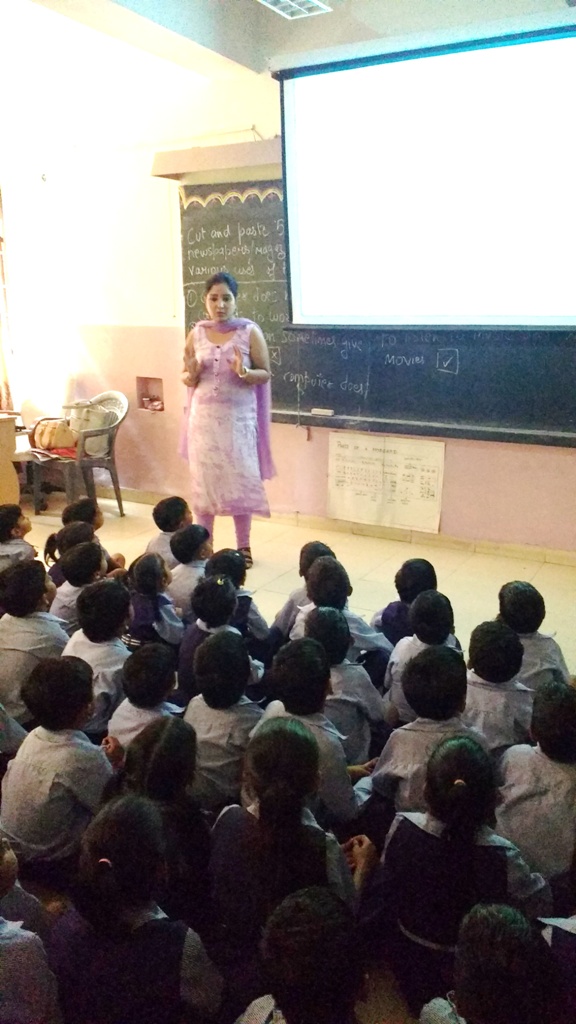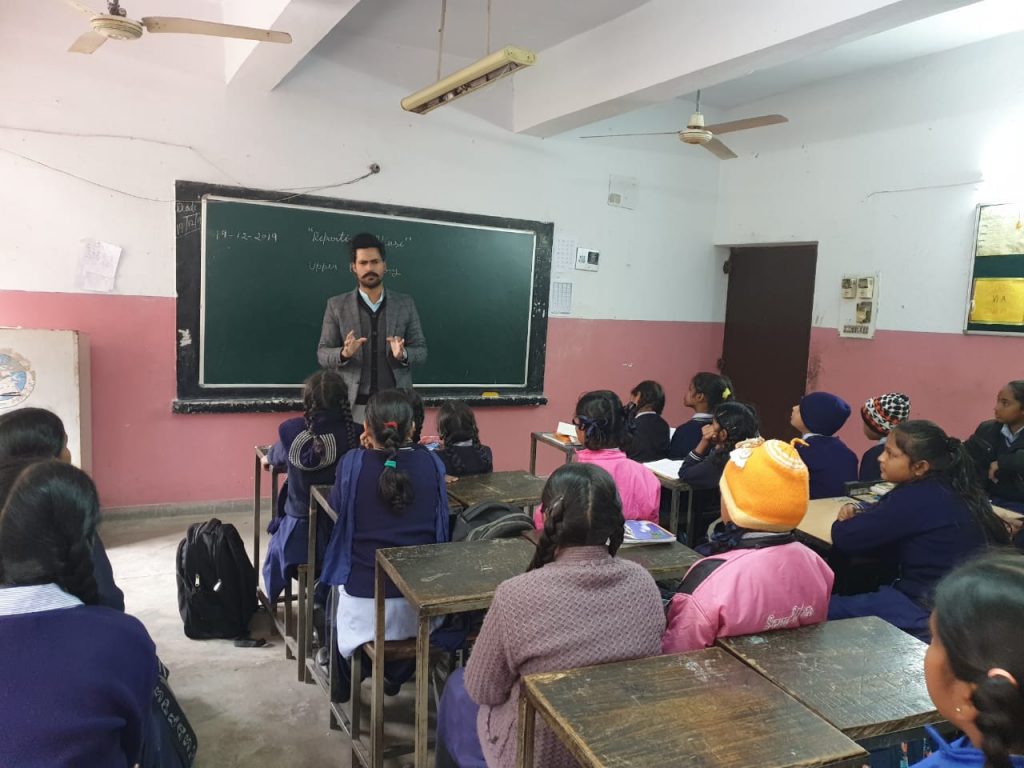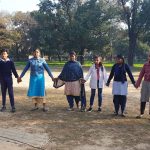The computer lab is fully equipped with computers and their accessories. Networking of all computers is done. This lab is fully maintained and is located at the ground floor right next to the Principal room. Computer instructor take care of the lab. TFT’s are installed in labs which consume less power & take less storage space.
Category: INFRASTRUCTURE
MULTIMEDIA LAB
The multimedia Lab is constructed on first floor of our school .It is fully equipped with 50 chairs , a projector, a screen, a podium in which speakers, a computer are attached. Labs also equipped with LCD projectors. Now students easily understand the difficult topics by using
MATH LAB
The Maths lab is located on the first floor of our school.Our Maths lab is a place which is rich in manipulative material readily accessed by students. In Maths Lab, all the models & accessories are available which are important for the experiments conducted by the students. These experiments are conducted under the proper observation of teachers.
SCIENCE LAB
The school has well equipped science lab which help students to understand chemistry ,physics experiments. The students are also given proper safety instructions to be followed in the lab. The preserved specimens are displayed which the students look with great interest. Models of Human skeleton ,Human ear, Human teeth are in the lab.
ACADEMICS
Inclusive Education :-There are total of 8 students which come under CWSN .They are studying in normal classes but special resource teachers are recruited by SSA which occasionally visit to school and provide guidance to the teachers.! Special Training Centre is running in our school under SSA.
SPORTS
principal mam board phoenix
PHOENIX
UT Education Department launched ‘Phoenix’ project for classes I to VIII under the
Samagra Shikhsha Abhiyan. While explaining the word ’Phoenix’ Education Secretary B
L Sharma said , “ The Name itself suggests rising from the ashes and this is what we aim
to do”. The key objective of starting this project is:-
The project aims at improving the learning outcomes of students and tracking their progress. The progress of each
student after completion of a unit or after the attainment of the set learning outcome will be maintained.
The project is targeted at students belonging to disadvantaged sections of society and residents of the peripheral areas.
A progress sheet has been devised to identify achievement level as per the learning outcome through grades A (beyond
the expected standards) , B (approached the expected standard) ,C (approaching the expected standard), D(not
meeting the expected standard) or star rating.
Under the project, officials of Education department will constitute as monitoring team for school visits. This time , all
eyes will be on the UT for performance in PISA.
THE BHARAT SCOUTS AND GUIDES
DEFINITION:- The Bharat Scout and Guide are volunteer, non political, educational
movement for young people, open to all without distinction of origin, race or creed in
accordance with the purpose conceived by the founder Lord Baden Powell in 1907
Purpose:- It is to contribute to the development of young people in achieving their full
physical intellectual , emotional , social and spiritual potential as individuals as
responsible and as a members of local , national and international communities.
Club Promise
I promise to do my best
To do my duty to God and my country
To keep the club law
To do good turn everyday
Bulbul Promise
I promise to do my best
To do my duty to God and my country
To keep the bulbul law
To do good turn everyday
Club/Bulbul Law
The club /bulbul is obedient.
The club/ bulbul is clean and polite.
Scout Promise
On my honour ”I promise that I will do my best to duty to God and country to help other people and to obey the scout
law.”
Scout Promise
On my honour ”I promise that I will do my best to do my duty to God and country to help other people and to obey the
scout law.”
Scout/Guide law
A Scout/Guide is trustworthy.
A Scout/Guide is loyal.
A Scout/Guide is friend to all and a brother /sister to every other scout /guide.
A Scout/Guide is courageous.
A Scout/Guide is thrifty.
A Scout/Guide is pure in thought, word and deed.
PISA
Programme for International Students Assessment
by
Organization for Economic Co-operation and Development (OECD)
Formed in – 1997
OECD headquarter – Paris (France)
Official language – English & French
India Participated – 2018 (72th rank –Tamilnadu)
Age of Measurement – 1 Feb 2005-31 Jan 2006
15 years 3 months – 16 years 2 months
5252 students (150 schools x 35 students) will be assessed.
Why PISA for India
Will help introduce competency based examination reforms in the school system.
Will discourage rote learning.
Lead to recognition and acceptability of Indian students & prepare them for global economy of 21 st century.
Will evaluate education system by measuring 15 yrs old school pupils (Mathematics, Science & Reading abilities.)
It is for improving/enabling countries to improve their education policies & outcomes.
The following actions/steps will be taken up by Education Department, UT Chandigarh:
- 100% coverage of teachers has to be ensured for PISA training by the Expert Committees and SCERT at the earliest.
- One integrated period per week (classes 6 to 10 ) may be introduced for integrated approach to learning that would
include real life situations, more than 1 teacher and student led class. - Art, Music and Physical Education teachers may be made part of integrated classroom.
- No Bag Day/PISA Day may be initiated for students once a week.
- Field trips-may be encouraged (visit gas station, railway station, parks, farms, post office etc.)
- Mentoring of students-One teacher may be allocated for mentoring of 5-6 students
- Students should be encouraged to give example and generate questions, promote peer interaction and learning as
pedagogy. - Reading has to be extensively promoted:-
a. Teachers will be instructed to ask students to bring newspaper articles related to the topic being taught the
next day.
b. One mandatory reading exercise for the class per day may ne planned in school time table; teachers may take
newspaper or other interesting articles for class reading and discussion-it should be undertaken on rotation
basis by different teachers e.g. Science teacher on Monday, Math teachers on Tuesday and so on. - Student wise plans also have to be prepared-highlighting each student’s specific challenges and strengths.
- Real Life situations have to be added for the content mapped in each area by the Expert Committees and the
methodology adopted by ICSE in teaching of languages may be studied and capitalized upon.
SPECIAL TRAINING CENTRE
A child 6-14 years of age will be considered out of school if he/she has never been
enrolled in an elementary school or if after enrollment has been absent from school
without prior intimation for reasons of absence for a period of 45 days or more.
Special Training Centre are set up to prepare out of school children for age appropriate
class. Special Training for out of school children Section 4 of the R.T.E. Act makes
specific provision for special Training for age appropriate admission for out of school
children.
The Principles of STC are:-
Treat the child with respect and dignity.
Make efforts to bring together children to build a sense of community.
Encourage children to take part in activities.
If a child is homesick make arrangements to take them home and for this return.
Develop an interest in active learning through the process of play and a print rich exciting environment.
NISHTHA
(NATIONAL INITIATIVE FOR SCHOOL HEADS TEACHERS HOLISTIC ADVANCEMENT)
The department of School Education and Literacy has launched a National Mission to
improve learning outcomes at the elementary level through an integrated Teacher
Training Programme called NISHTHA under the centrally sponsored scheme of
Samagara Shiksha in 2019-20.
NISHTHA is a capacity building programme for “Improving Quality of School education
through integrated Teacher Training.” It aims to build competencies among teachers
and school principals at the elementary stage. The basic objective of this massive
training programme is to motivate and equip teachers to encourage and foster critical
thinking among students. The key objective of starting this project is:-
Capacity building of 4.2 million teachers
Integrated training of Principals/ heads as key academic support.
Focus on competency and higher order thinking skills based teaching- learning.
Training of all heads and teachers as first level counselors.
Promoting experimental and joyful learning.
Awareness of centrally sponsored schemes/initiatives.
Creation of healthy and safe school environment.
Integration of ICT in teaching learning and assessment.
Develop stress free school based assessment.
Use of Art as pedagogy leading to increased creativity and innovation among students.
To create enabling and enriching inclusive classroom environment.
To improve learning outcomes of the students.
COMMITTEES & ITS MEMBERS
LEGAL CELL MRS SOPHIA HARDY
MRS VEENA KATARIA
MR SHYAMANANAD JHA
BAAL SANSAD MR SHYAMANAND JHA
MRS ANJNA SANKHIAN
MRS GEETA SHARMA
LEGAL CLUB MRS HARMNEET KAUR
MR JASVIR SINGH
MRS SOPHIA HARDY
MR SHYAMANAND JHA
MRS MEENA KUMARI
MRS ANURADHA
MS NAVREET KAUR
ECO CLUB MRS VANITA GOYAL
MRS RAMANJIT KAUR
SEXUAL HARASSMENT MR SUDESH SHARMA
MRS SOPHIA HARDY
MRS SUDARSHNA KUMARI
MRS MEENA KUMARI
MR BHUSHAN KUMAR
MS NAVREET KAUR
CHILD FRIENDLY MR SUDESH SHARMA
MR SHYAMAND JHA
MRS ANURADHA
MR BHUSHAN KUMAR
MS NAVREET KAUR
SCIENCE CLUB MRS VANITA GOYAL
MRS RAMANJIT KAUR
EXAMINATION MRS SOPHIA HARDY
MRS SUDARSHNA KUMARI
COMMITTEES & ITS MEMBERS
HEALTH MRS GEETA SHARMA
MRS MONIKA ARORA
SMDC MRS VANITA GOYAL
MR SARABJIT SINGH
PURCHASE MR SUDESH SHARMA
MRS SUDARSHNA KUMARI
MR BALBIR ISNGH
MR SATISH KUMAR
MR SARABJIT SINGH
RESULT MRS GURJEET KAUR
MS BHARTI WALIA
BOOKS MRS ANJU SEHGAL
MRS MONIKA
CLASSROOM OBSERVATION MRS SUMAN SAHRMA
MRS DR BHARTI GUPTA
MRS MONIKA ARORA
MR BHUSHAN KUMAR
MS UPASANA
CANTEEN MR JASVIR SINGH
MRS SUDARSHNA KUMARI
MRS SUNITA DEWAN
MRS ANURADHA
MR SATISH KUMAR
HUBS OF CBSE LEARNING MRS BHARTI GUPTA
MRS ANJNA
MS NAVREET KAUR
MS MONIKA ARORA
Backed by international community

The international community is a phrase used in geopolitics and international relations to refer to a broad group of people and governments of the world. It does not refer literally to all nations or states in the world. The term is typically used to imply the existence of a common point of view towards such matters as specific issues of human rights. Activists, politicians and commentators often use the term in calling for action to be taken; e.g., action against what is in their opinion political repression in a target country.
The term is commonly used to imply legitimacy and consensus for a point of view on a disputed issue; e.g., to enhance the credibility of a majority vote in the United Nations General Assembly.
Noam Chomsky alleges that the use of the term is used to refer to the United States and its allies and client states, as well as allies in the media of those states. The scholar and academic Martin Jacques says: “We all know what is meant by the term ‘international community’, don’t we? It’s the west, of course, nothing more, nothing less. Using the term ‘international community’ is a way of dignifying the west, of globalising it, of making it sound more respectable, more neutral and high-faluting.”
Environmental issues are harmful effects of human activity on the biophysical environment. Environmental protection is a practice of protecting the natural environment on individual, organizational or governmental levels, for the benefit of both the environment and humans. Environmentalism, a social and environmental movement, addresses environmental issues through advocacy, education and activism.
The carbon dioxide equivalent of greenhouse gases (GHG) in the atmosphere has already exceeded 400 parts per million (NOAA) (with total “long-term” GHG exceeding 455 parts per million) (Intergovernmental Panel on Climate Change Report). This level is considered a tipping point. “The amount of greenhouse gas in the atmosphere is already above the threshold that can potentially cause dangerous climate change. We are already at risk of many areas of pollution…It’s not next year or next decade, it’s now.” The UN Office for the Coordination of Humanitarian Affairs (OCHA) has stated “Climate change is not just a distant future threat. It is the main driver behind rising humanitarian needs and we are seeing its impact. The number of people affected and the damages inflicted by extreme weather has been unprecedented.” Further, OCHA has stated:
Climate disasters are on the rise. Around 70 percent of disasters are now climate related – up from around 50 percent from two decades ago.
These disasters take a heavier human toll and come with a higher price tag. In the last decade, 2.4 billion people were affected by climate related disasters, compared to 1.7 billion in the previous decade. The cost of responding to disasters has risen tenfold between 1992 and 2008.
Destructive sudden heavy rains, intense tropical storms, repeated flooding and droughts are likely to increase, as will the vulnerability of local communities in the absence of strong concerted action.
Hot Air Balloon Competition Sky 2017
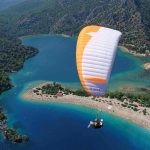
A hot air balloon is a lighter than air aircraft consisting of a bag, called an envelope, which contains heated air. Suspended beneath is a gondola or wicker basket (in some long-distance or high-altitude balloons, a capsule), which carries passengers and (usually) a source of heat, in most cases an open flame. The heated air inside the envelope makes it buoyant since it has a lower density than the colder air outside the envelope. As with all aircraft, hot air balloons cannot fly beyond the atmosphere. Unlike gas balloons, the envelope does not have to be sealed at the bottom, since the air near the bottom of the envelope is at the same pressure as the surrounding air. In modern sport balloons the envelope is generally made from nylon fabric and the inlet of the balloon (closest to the burner flame) is made from a fire resistant material such as Nomex. Modern balloons have been made in all kinds of shapes, such as rocket ships and the shapes of various commercial products, though the traditional shape is used for most non-commercial, and many commercial, applications.
The hot air balloon is the first successful human-carrying flight technology. The first untethered manned hot air balloon flight was performed by Jean-François Pilâtre de Rozier and François Laurent d’Arlandes on November 21, 1783, in Paris, France, in a balloon created by the Montgolfier brothers. The first hot-air balloon flown in the Americas was launched from the Walnut Street Jail in Philadelphia on January 9, 1793 by the French aeronaut Jean Pierre Blanchard. Hot air balloons that can be propelled through the air rather than simply drifting with the wind are known as thermal airships.
The French brothers Joseph-Michel and Jacques-Étienne Montgolfier developed a hot air balloon in Annonay, Ardeche, France, and demonstrated it publicly on September 19, 1783, making an unmanned flight lasting 10 minutes. After experimenting with unmanned balloons and flights with animals, the first balloon flight with humans aboard, a tethered flight, performed on or around October 15, 1783, by Jean-Francois Pilatre de Rozier who made at least one tethered flight from the yard of the Reveillon workshop in the Faubourg Saint-Antoine. Later that same day, Pilatre de Rozier became the second human to ascend into the air, reaching an altitude of 26 m (85 ft), the length of the tether. The first free flight with human passengers was made a few weeks later, on November 21, 1783.King Louis XVI had originally decreed that condemned criminals would be the first pilots, but de Rozier, along with Marquis François d’Arlandes, petitioned successfully for the honor. The first military use of a hot air balloon happened in 1794 during the battle of Fleurus, when the French used the balloon l’Entreprenant for observation.
Post navigation
How To Climb The Career Latter And Don’t Waste Your Youth
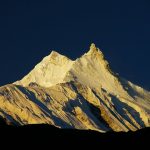
The term mountaineering describes the sport of mountain climbing. While some scholars identify mountaineering-related activities as climbing rock and ice and trekking up mountains, others are also adding backpacking, hiking, skiing, via ferrata and wilderness activities, and still others state that mountaineering activities also include indoor climbing, sport climbing and bouldering.However, to most of the scholars, the term mountaineering is understood as climbing which now refers to adventure climbing or sports climbing and trekking hill walking in ‘exotic’ places.Hiking in the mountains can also be a simple form of mountaineering when it involves scrambling, or short stretches of the more basic grades of rock climbing, as well as crossing glaciers.
While mountaineering began as attempts to reach the highest point of unclimbed big mountains it has branched into specializations that address different aspects of the mountain and consists of three areas: rock-craft, snow-craft, and skiing, depending on whether the route chosen is over rock, snow or ice. All require experience, athletic ability, and technical knowledge to maintain safety.
Mountaineering is often called Alpinism, especially in European languages, which implies climbing routes with minimal equipment in high and often snow and ice-covered mountains such as the Alps, where technical difficulties frequently exceed environmental and physical challenges. A mountaineer who pursues this more technical and minimalist style of mountain climbing is sometimes called an Alpinist, although use of the term may vary between countries and eras. The word “alpinism” was born in the 19th century to refer to climbing for the purpose of enjoying climbing itself as a sport or recreation, distinct from merely climbing while hunting or as a religious pilgrimage that had been done generally at that time.
